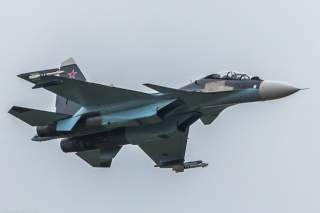Russia's Next Big Weapons Sale: Is the Lethal Su-30 Fighter Iran Bound?
From Russia with missiles?
Iran is interested in acquiring Russian-made Sukhoi Su-30 Flankers for its air force. An Iranian delegation discussed the matter with Russian officials at the MAKS airshow outside Moscow last month, according to Iranian state media.
“We are discussing the purchase of Sukhoi fighter planes,” Iranian defense minister Brig. Gen. Hossein Dehqan told the Lebanon-based al-Mayadeen news network according to Iran’s Press TV on Aug. 30.
Russian president Vladimir Putin was apparently present for the discussions as was Iranian vice president for science and technology affairs Sorena Sattari according to a report from the Iranian FARS News agency. It is not clear which version of the Su-30 Iran is interested in, but presumably it would be one of the advanced variants similar to the aircraft operated by India, Malaysia, Algeria and Russia itself.
However, it is also possible that Iran could opt for a variant of the more basic Su-30M2, which is also in service with the Russian Air Force. That variant is somewhat less expensive, which might make more sense considering Iran’s economic situation.
The Su-30M2 variant, which is built in Komsomolsk-on-Amur in Russia’s Far East, is missing the Su-30SM’s canards, thrust vectoring nozzles and has a less comprehensive avionics suite. Either way, the addition of any Su-30 variant would greatly increase the capabilities of the Iranian air force, which is mostly equipped with an antiquated mix of U.S., Russian and Chinese-built hardware.
The most advanced aircraft Iran has are a handful of American-built Grumman F-14A Tomcats and MiG-29s acquired either from the Soviet Union or aircraft that defected from Iraq. The rest of its arsenal is composed of geriatric F-4 Phantom IIs, locally modified F-5 Freedom Fighters and Chinese-build F-6 and F-7 aircraft—derivatives of the MiG-19 and the MiG-21 respectively. Most of Iran’s “indigenous” aircraft developments have been modifications to the Northrop F-5 airframe or ridiculous papier-mâché mockups like the Qaher-313 farce.
The Iranian military is not particularly capable in a conventional fight. If the Iranians relied on anti-access/area denial strategies—sea mines, swarming boat attacks on U.S. Navy strike groups or missile attacks against U.S. bases in the region—it might be able to cause some problems for the U.S. military and its allies. Buying advanced surface-to-air missile systems the like the S-300 or Buk to bolster that strategy might be a better investment for Iran than a new fighter. Of course, it must be noted that the Iranians have tried to purchase the S-300—but Russia never delivered the weapons.
The addition of a significant number of Su-30s would increase Iran’s air power capability; there is no doubt about that. But the overall balance would still remain in favor of U.S. allies in the Gulf. That’s especially true when one considers the fact that the United States will unavoidably be dragged into any conflict with between Iran and its neighbors. Iranian’s conventional forces stand no chance in a force on force encounter with the U.S. military with or without Su-30s flying on their side.
In short, the Iranian air force is completely outclassed by all of its Gulf neighbors who operated advanced F-15s, F-16s and Eurofighter Typhoons—Su-30s or not.
Dave Majumdar is the defense editor for The National Interest.
Image: Creative Commons.

